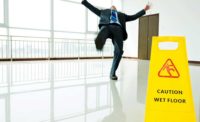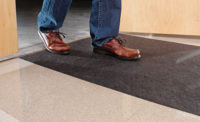Occupational slips, trips, and falls on the same level (STFL), have been a severe problem in the workplace for decades. Some of the most recent data about their financial impact on business comes from the Liberty Mutual Workplace Safety Index. Their research finds that the direct cost of STFL is approximately $10 billion annually. Indirect costs, such as loss of worker productivity, can be significantly more than this.
It appears that the first symposiums and conferences dedicated to a better understanding STFLs and their causes were not conducted until the early 1980s, although billions of dollars each year are on the line, not to mention the human impact. However, since then, several conferences have, among other things, helped us define more specifically all the components that make up an STFL.
For instance, researchers now define slipping as: something that occurs when the foot or sole of a shoe and the floor surface is insufficient to counteract the forward force that occurs during the walking process. Taking this a step further, they also point out there are three types or categories:
- Microslip. This is a slip that is shorter than 3 cm, a bit more than one inch.
- Slip. This is a slip that is as much as 10 cm, or about four inches.
- Slide. This is an uncontrolled movement of the heel; it often exceeds the length of a slip and can be 10 cm or more.
A microslip often passes totally unnoticed. A slip is just short enough to allow us to take action and regain our postural control instinctively. However, a slide is typically a total loss of balance, resulting in a fall.
We should also note that a trip can occur when walking is interrupted unexpectedly. A foot gets trapped in an unnoticed cord strewn across a walkway, for example. Trips lead to a loss of balance, resulting in a fall.
Factors influencing STFL frequencies
Since the 1980s, studies have also been conducted to see who is most impacted by STFL. While the results of these studies are not always the same, many have come to the following conclusions:
- Age. Some studies have pointed out that older workers have more STFLs than younger workers. However, other studies have found just the opposite. In many cases, older workers are more careful where and how they walk, taking extra care not to experience an STFL. Younger workers tend to be a bit less concerned about the safety of walkways, how fast they walk, or the possibility that they might experience an STFL.
- Work location. As would be expected, those who work in the office areas of an organization tend to have fewer STFLs than those working in the more industrial work areas of the facility.
- Pace. Due to several factors, a faster pace or walking speed at work tends to result in more STFLs. Further, the number of STFLs goes up when workers report they felt rushed to complete a task.
- Load carrying. STFLs increase when workers are carrying items in their hands, notably heavier items. We have more control over our posture, our arm swing, and our gait when our arms are free.
STFL prevention strategies
Now that we have a more complete understanding of all the dynamics of STFLs, our concern is how to prevent them in the workplace. Our goal here is to try and provide new insights and uncover new preventive strategies that may help administrators better ensure the safety of their workforce and reduce STFLs.
- Floor shine. What we see happening in many industrial locations is that administrators are no longer applying any type of finish to their floors. In those situations where a floor finish can be applied, it is often best to apply a finish with a high-gloss shine. Different studies indicate that workers think a slip is more likely on a shiner floor. Ironically, in most cases a finish that produces a high-gloss shine also has slip-resistant qualities. In other words, the more shine, the safer it may actually be.
- Risk elimination. While not necessarily a new strategy, as most administrators know, OSHA requires that “only qualified persons be permitted to inspect, maintain or repair walking and working surfaces.” These persons are “capable of identifying existing or potential hazards in specific surroundings or working conditions which may be hazardous or dangerous to employees; and has been trained for the specific task assigned.”
- Unusual safety signage. While safety signs and floor cones are often mentioned when it comes to preventing STFLs, administrators should note that selecting a more unusual type of floor cone may prove to be more effective in reducing STFLs. Most safety cones are two- or three-sided. They have been used for years and because of that, their impact when it comes to safety appears to be diminishing. Because of this, alternatives have been developed that are still OSHA-compliant. For instance, some are designed to look like bananas, of all things, but they work. Why? Because they stand out, they catch walkers’ attention, and they make people think safety.
Some of the latest numbers when it comes to slips, trips, and falls indicate the number of incidents in the workplace has been coming down. However, this downward trend is moving slowly and in small increments. Invariably, it is up to facility administrators to take the lead here. They are tasked with providing a safe workplace and, with a better understanding of STFLs, this is certainly possible.



